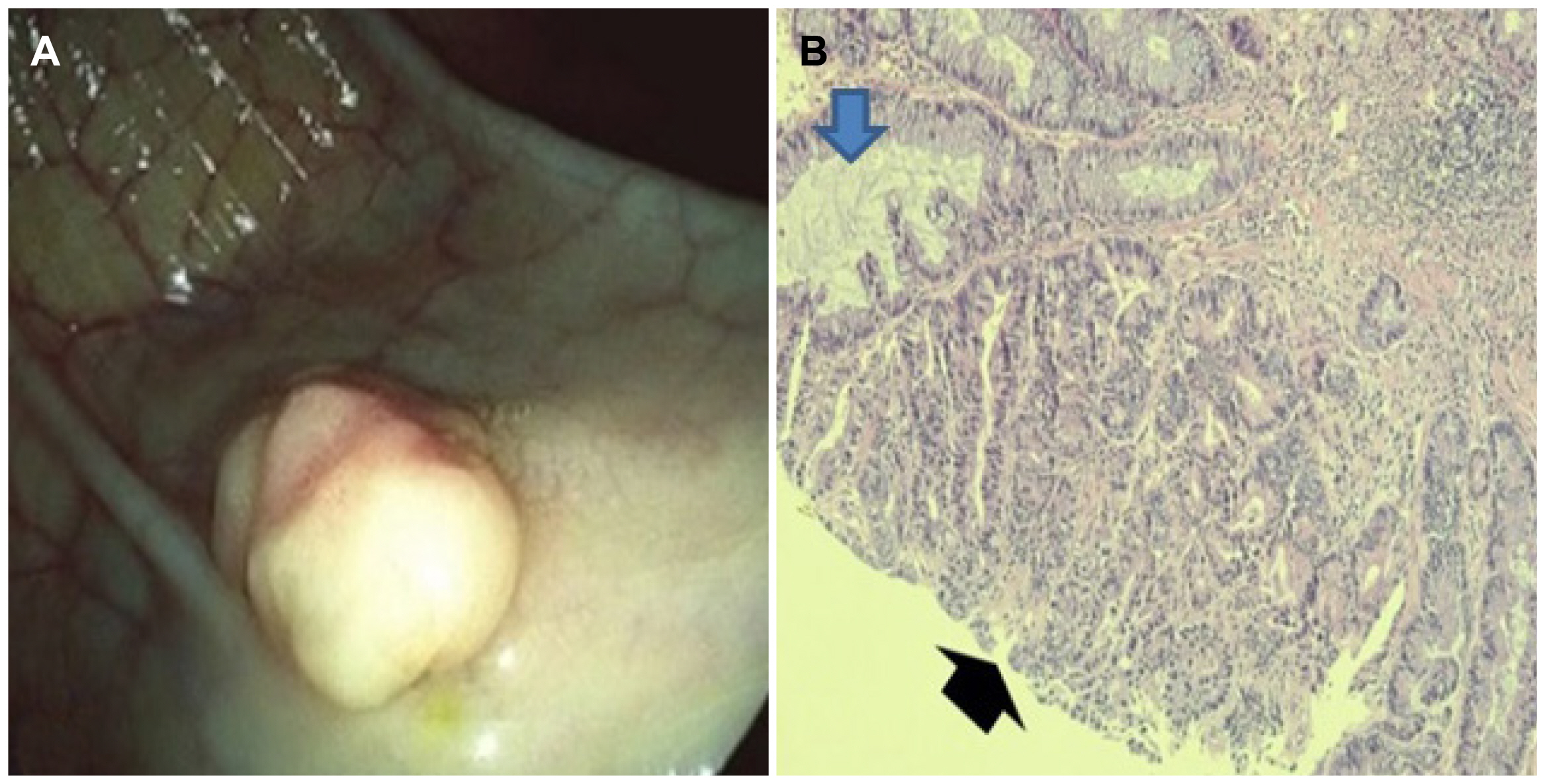Korean J Gastroenterol.
2020 Sep;76(3):159-163. 10.4166/kjg.2020.76.3.159.
Serrated Polyposis Syndrome with a Synchronous Colon Adenocarcinoma Treated by an Endoscopic Mucosal Resection
- KMID: 2506672
- DOI: http://doi.org/10.4166/kjg.2020.76.3.159
Abstract
- Serrated polyposis syndrome (SPS) can transform to malignant lesions through the sessile serrated pathway and traditional serrated pathway. These pathways may cause rapid neoplastic progression compared to the adenoma-carcinoma sequence, which may cause interval colorectal cancer. The authors experienced a case of SPS with a synchronous colon adenocarcinoma that was treated with an endoscopic mucosal resection. In pathology reviews, other parts of the adenocarcinoma showed sessile serrated adenoma. Therefore, patients with SPS have a potential for malignant transformation, highlighting the need for strict colonoscopy surveillance starting at the time of SPS diagnosis.
Figure
Reference
-
1. Dekker E, Bleijenberg A, Balaguer F. Dutch-Spanish-British Serrated Polyposis Syndrome Collaboration. 2020; Update on the World Health Organization criteria for diagnosis of serrated polyposis syndrome. Gastroenterology. 158:1520–1523. DOI: 10.1053/j.gastro.2019.11.310. PMID: 31982410.
Article2. Edelstein DL, Cruz-Correa M, Soto-Salgado M, et al. 2015; Risk of colorectal and other cancers in patients with serrated polyposis. Clin Gastroenterol Hepatol. 13:1697–1699. DOI: 10.1016/j.cgh.2015.02.003. PMID: 25681317. PMCID: PMC4532657.
Article3. Yamauchi T, Watanabe M, Hasegawa H, et al. 2002; Serrated adenoma developing into advanced colon cancer in 2 years. J Gastroenterol. 37:467–470. DOI: 10.1007/s005350200068. PMID: 12108682.
Article4. Pyleris E, Koutsounas IS, Karantanos P. 2014; Three colon adenocarcinomas arising in a patient with serrated polyposis syndrome: case report and review of the literature. Viszeralmedizin. 30:136–139. DOI: 10.1159/000360386. PMID: 26286237. PMCID: PMC4513800.
Article5. Chino A, Nagayama S, Ishikawa H, et al. 2016; Cancer emerging from the recurrence of sessile serrated adenoma/polyp resected endoscopically 5 years ago. Jpn J Clin Oncol. 46:89–95. DOI: 10.1093/jjco/hyv154. PMID: 26538462.
Article6. Noffsinger AE, Hart J. 2010; Serrated adenoma: a distinct form of non-polypoid colorectal neoplasia? Gastrointest Endosc Clin N Am. 20:543–563. DOI: 10.1016/j.giec.2010.03.012. PMID: 20656251.
Article7. Torlakovic E, Snover DC. 1996; Serrated adenomatous polyposis in humans. Gastroenterology. 110:748–755. DOI: 10.1053/gast.1996.v110.pm8608884. PMID: 8608884.
Article8. Guarinos C, Sánchez-Fortún C, Rodríguez-Soler M, Alenda C, Payá A, Jover R. 2012; Serrated polyposis syndrome: molecular, pathological and clinical aspects. World J Gastroenterol. 18:2452–2461. DOI: 10.3748/wjg.v18.i20.2452. PMID: 22654442. PMCID: PMC3360443.
Article9. Walker RG, Landmann JK, Hewett DG, et al. 2010; Hyperplastic polyposis syndrome is associated with cigarette smoking, which may be a modifiable risk factor. Am J Gastroenterol. 105:1642–1647. DOI: 10.1038/ajg.2009.757. PMID: 20125129.
Article10. Rosty C, Walsh MD, Walters RJ, et al. 2013; Multiplicity and molecular heterogeneity of colorectal carcinomas in individuals with serrated polyposis. Am J Surg Pathol. 37:434–442. DOI: 10.1097/PAS.0b013e318270f748. PMID: 23211288. PMCID: PMC3567207.
Article11. Yamane L, Scapulatempo-Neto C, Reis RM, Guimarães DP. 2014; Serrated pathway in colorectal carcinogenesis. World J Gastroenterol. 20:2634–2640. DOI: 10.3748/wjg.v20.i10.2634. PMID: 24627599. PMCID: PMC3949272.
Article12. East JE, Atkin WS, Bateman AC, et al. 2017; British Society of Gastroenterology position statement on serrated polyps in the colon and rectum. Gut. 66:1181–1196. DOI: 10.1136/gutjnl-2017-314005. PMID: 28450390. PMCID: PMC5530473.
Article13. East JE, Saunders BP, Jass JR. 2008; Sporadic and syndromic hyperplastic polyps and serrated adenomas of the colon: classification, molecular genetics, natural history, and clinical management. Gastroenterol Clin North Am. 37:25–46. DOI: 10.1016/j.gtc.2007.12.014. PMID: 18313538.
Article14. Kim ER, Jeon J, Lee JH, et al. 2017; Clinical characteristics of patients with serrated polyposis syndrome in Korea: comparison with Western patients. Intest Res. 15:402–410. DOI: 10.5217/ir.2017.15.3.402. PMID: 28670238. PMCID: PMC5478766.
Article15. Kim HK, Seo KJ, Choi HH, et al. 2015; Clinicopathological characteristics of serrated polyposis syndrome in Korea: single center experience. Gastroenterol Res Pract. 2015:842876. DOI: 10.1155/2015/842876. PMID: 26064099. PMCID: PMC4443882.
Article16. Biswas S, Ellis AJ, Guy R, Savage H, Madronal K, East JE. 2013; High prevalence of hyperplastic polyposis syndrome (serrated polyposis) in the NHS bowel cancer screening programme. Gut. 62:475. DOI: 10.1136/gutjnl-2012-303233. PMID: 22851664.17. Elorza G, Enríquez-Navascués JM, Bujanda L, Larzábal M, Gil Lasa I, Martí L. 2014; Phenotype characteristics of patients with colonic serrated polyposis syndrome: a study of 23 cases. Cir Esp. 92:659–664. DOI: 10.1016/j.cireng.2014.02.020. PMID: 24795265.
Article18. Moreira L, Pellisé M, Carballal S, et al. 2013; High prevalence of serrated polyposis syndrome in FIT-based colorectal cancer screening programmes. Gut. 62:476–477. DOI: 10.1136/gutjnl-2012-303496. PMID: 22982987.19. Toyoshima N, Sakamoto T, Makazu M, et al. 2015; Prevalence of serrated polyposis syndrome and its association with synchronous advanced adenoma and lifestyle. Mol Clin Oncol. 3:69–72. DOI: 10.3892/mco.2014.423. PMID: 25469272. PMCID: PMC4251102.
Article20. Guarinos C, Sánchez-Fortún C, Rodríguez-Soler M, Alenda C, Payá A, Jover R. 2012; Serrated polyposis syndrome: molecular, pathological and clinical aspects. World J Gastroenterol. 18:2452–2461. DOI: 10.3748/wjg.v18.i20.2452. PMID: 22654442. PMCID: PMC3360443.
Article21. Suzuki D, Matsumoto S, Mashima H. 2017; A case with serrated polyposis syndrome controlled by multiple applications of endoscopic mucosal resection and endoscopic submucosal dissection. Am J Case Rep. 18:304–307. DOI: 10.12659/AJCR.902444. PMID: 28341823. PMCID: PMC5378300.
Article22. Bleijenberg AG, IJspeert JE, van Herwaarden YJ, et al. 2020; Personalised surveillance for serrated polyposis syndrome: results from a prospective 5-year international cohort study. Gut. 69:112–121. DOI: 10.1136/gutjnl-2018-318134. PMID: 30981990. PMCID: PMC6943249.
Article
- Full Text Links
- Actions
-
Cited
- CITED
-
- Close
- Share
- Similar articles
-
- Hyperplastic Polyposis Associated with Two Synchronous Colon Cancers
- Optimal Endoscopic Treatment and Surveillance of Serrated Polyps
- Endoscopic Resection of an Adenocarcinoma Arising from a Sporadic Tubulovillous Adenoma of the Duodenum
- Serrated Adenoma with Adenocarcinoma of Stomach Treated by Endoscopic Submucosal Dissection
- Clinical characteristics of patients with serrated polyposis syndrome in Korea: comparison with Western patients




